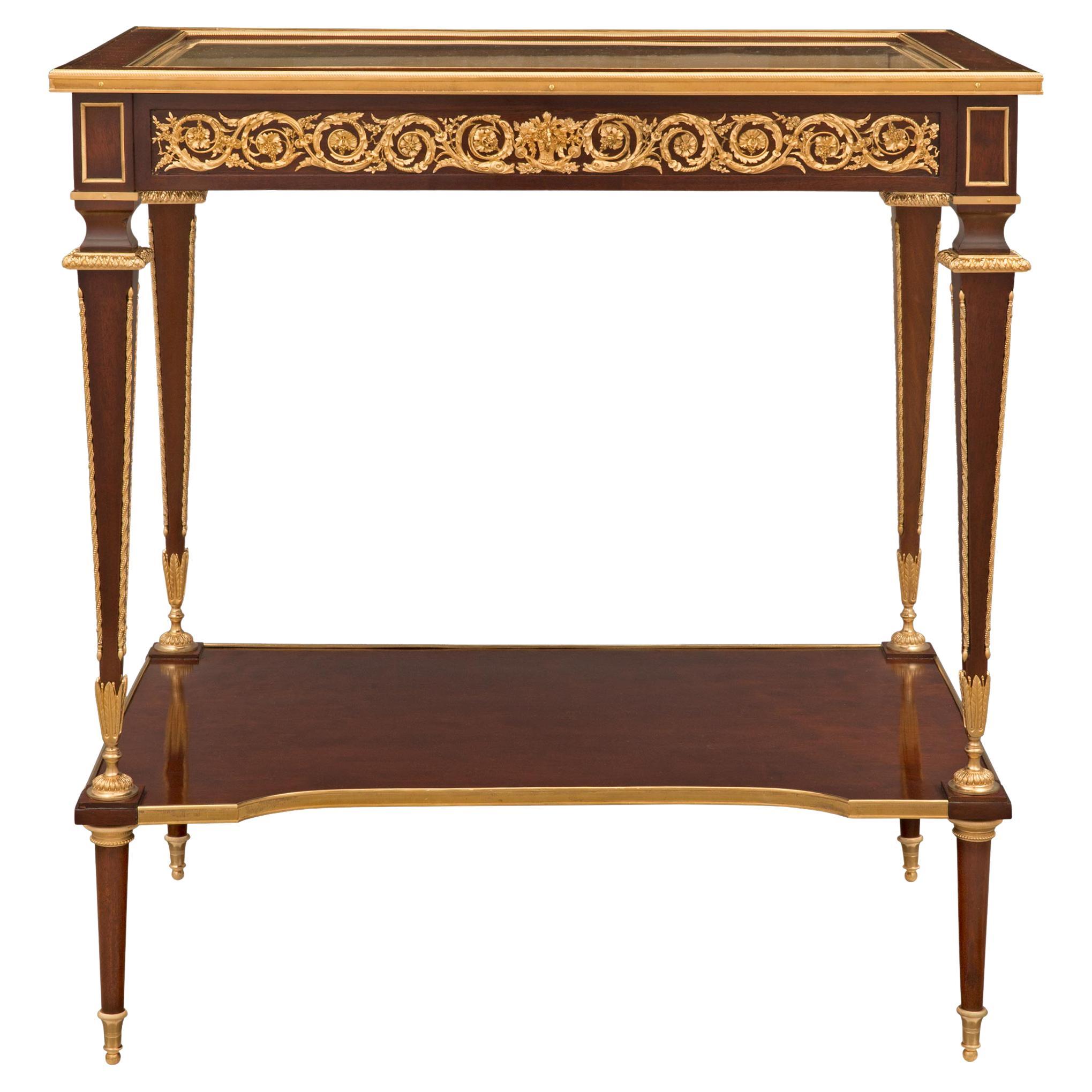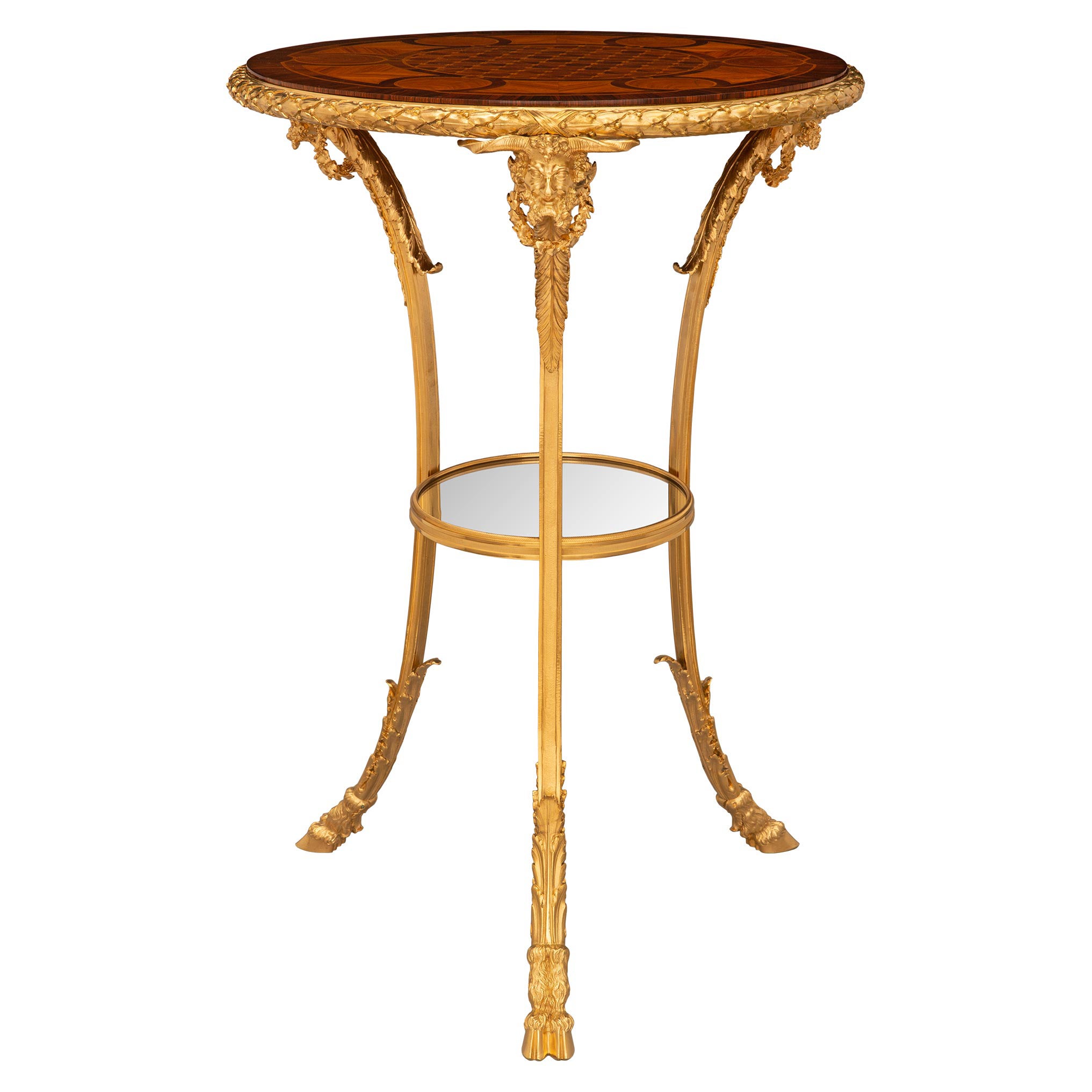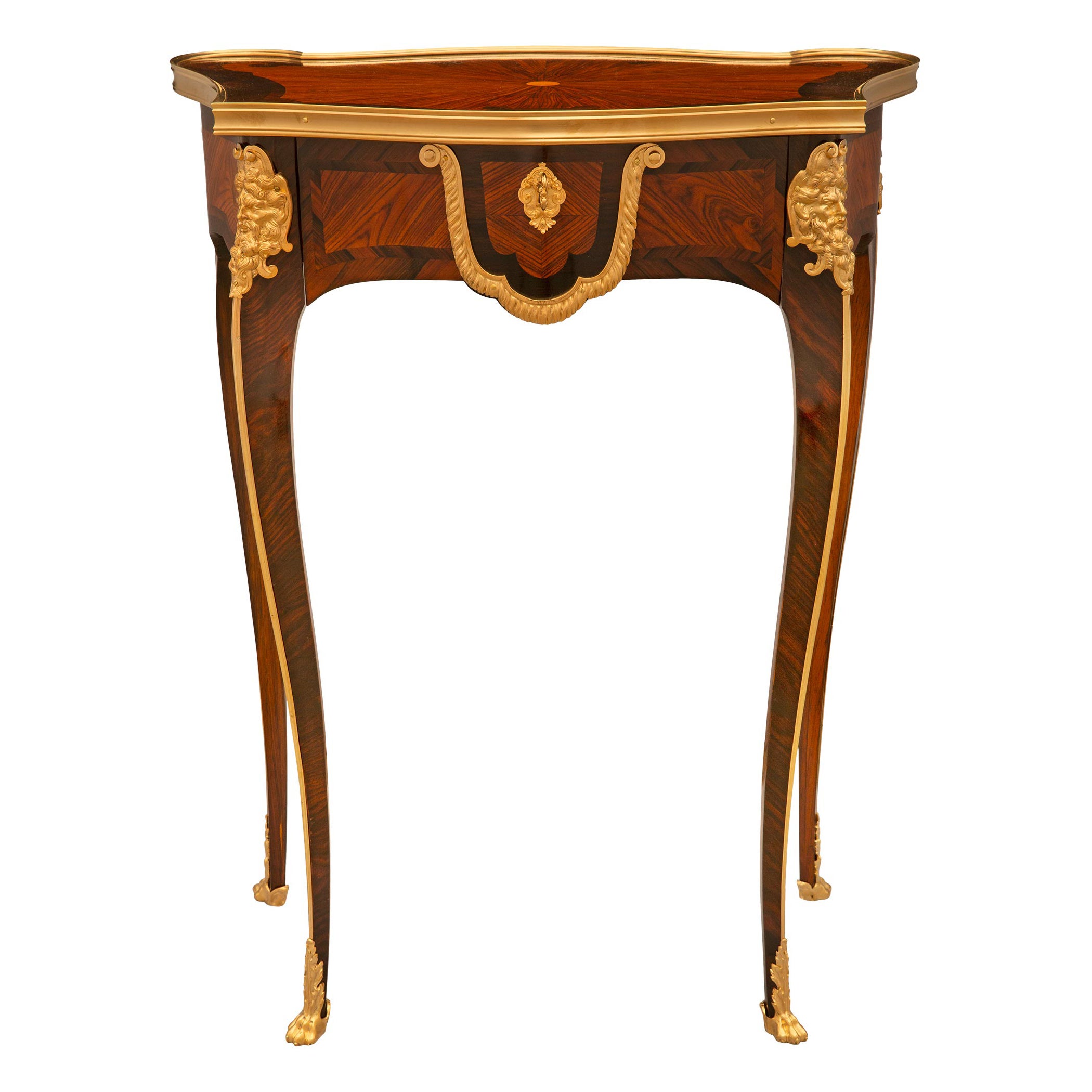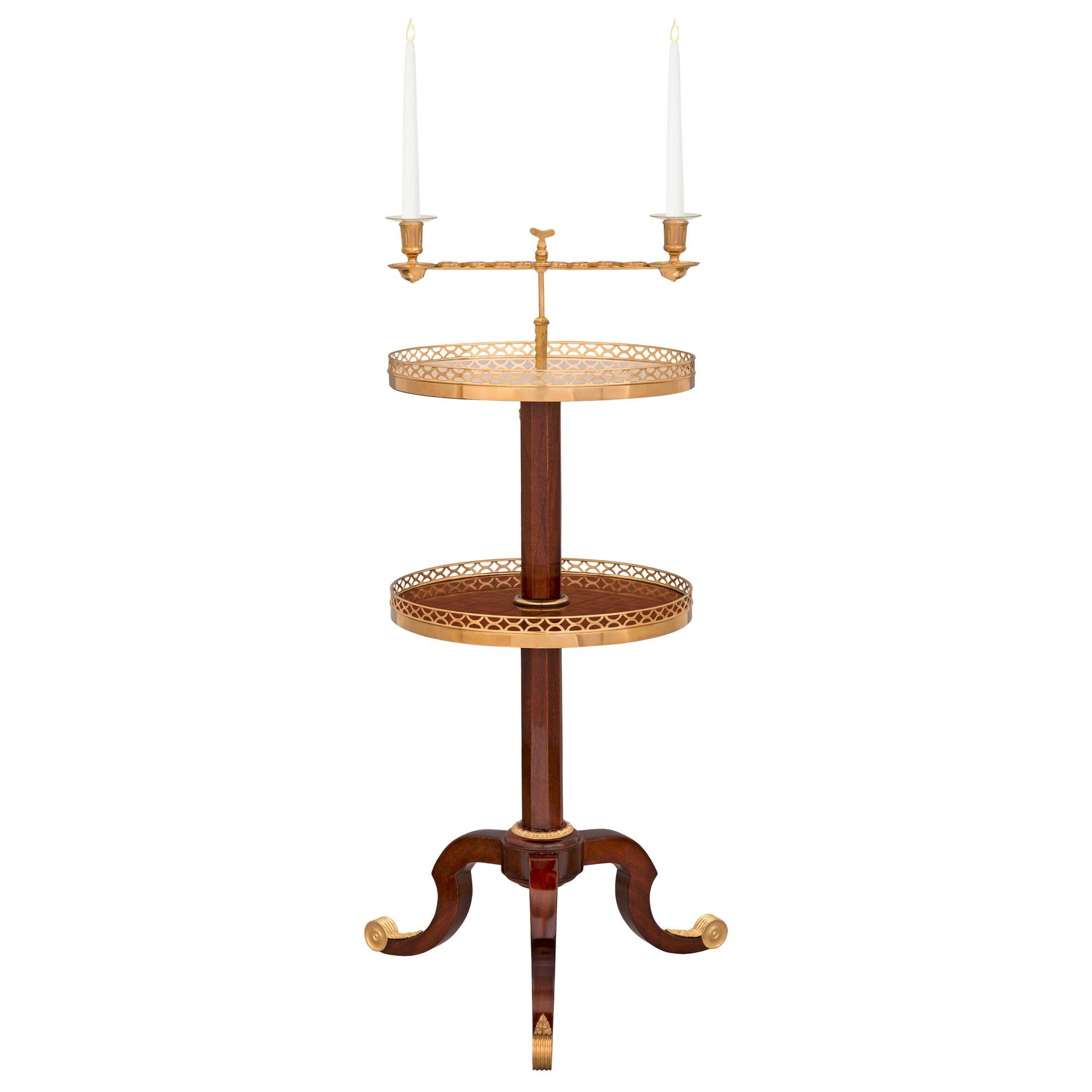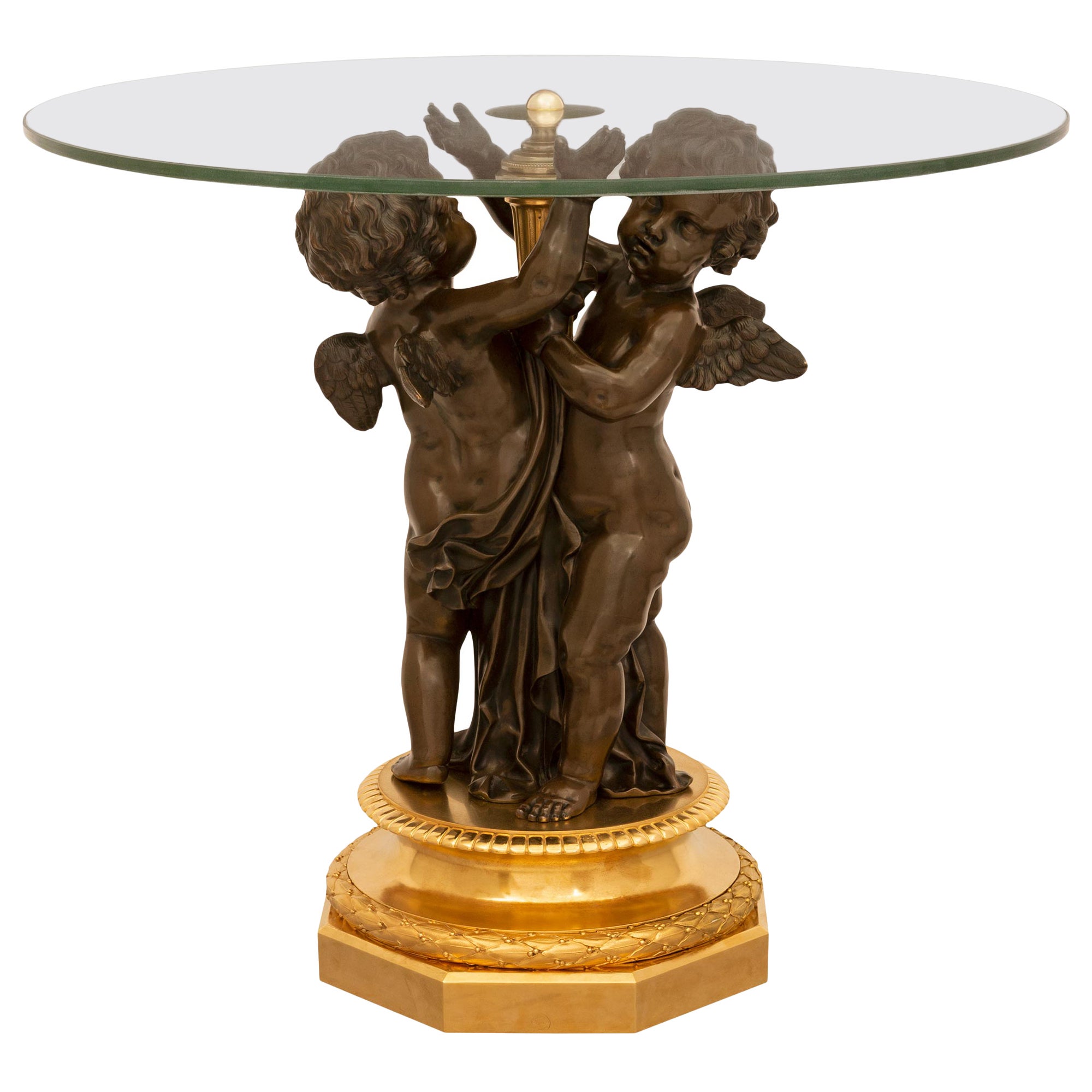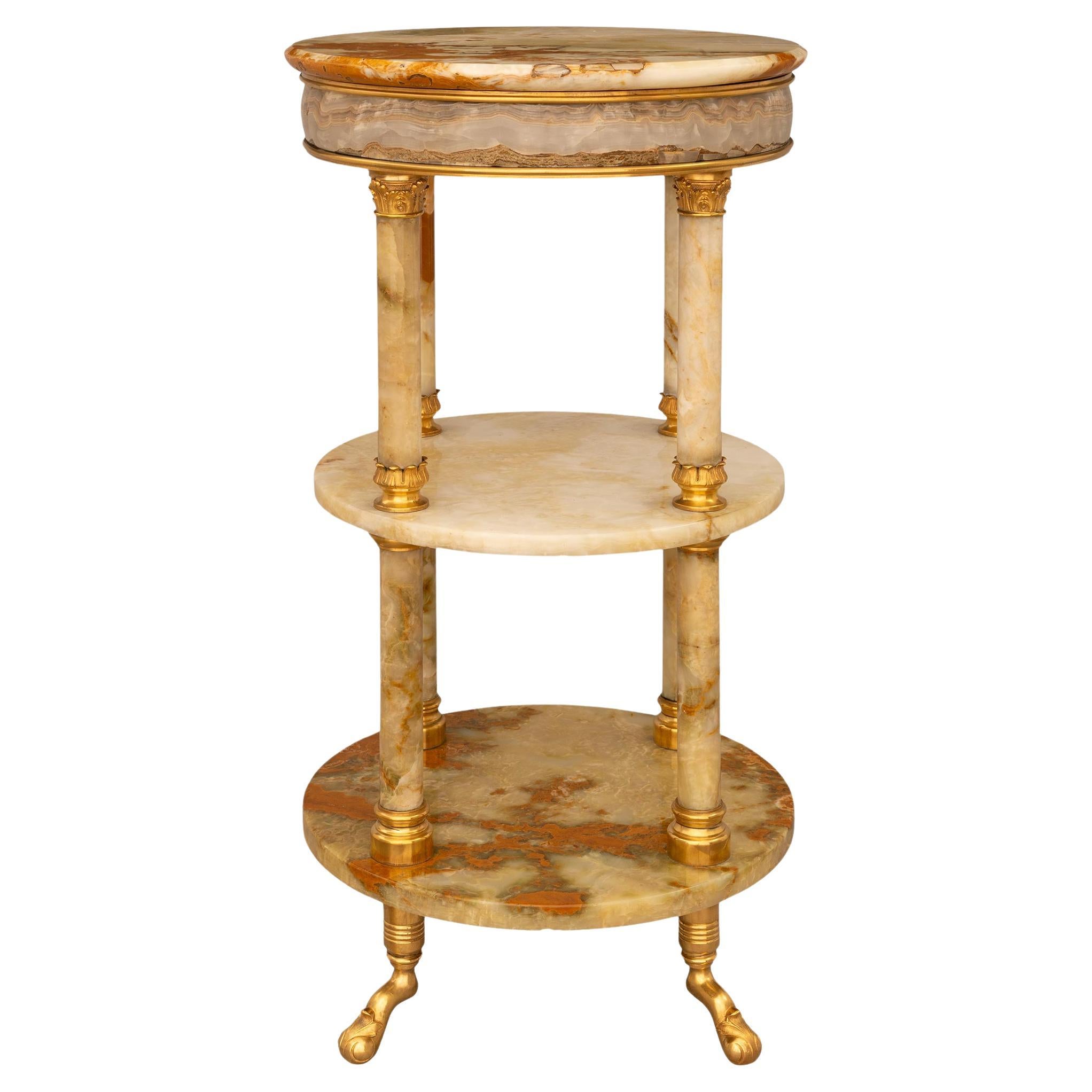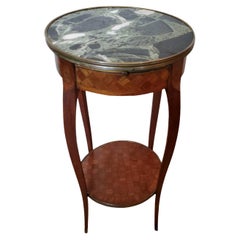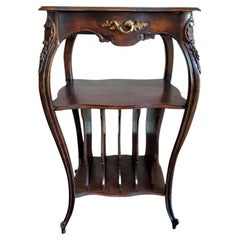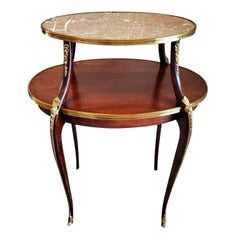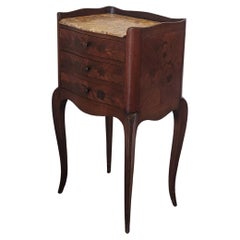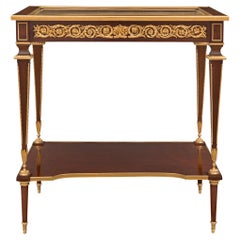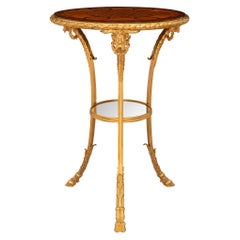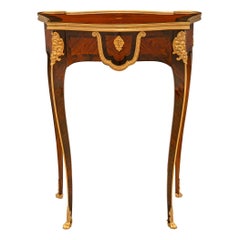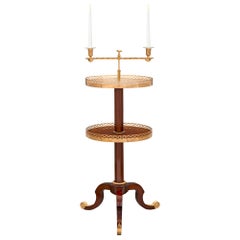Items Similar to 19th Century French Belle Époque Period Marquetry Tiered Table
Want more images or videos?
Request additional images or videos from the seller
1 of 11
19th Century French Belle Époque Period Marquetry Tiered Table
About the Item
A beautiful French La Belle Époque period mahogany inlaid two-tier etagere stand / side table from the second half of the 19th century.
Handcrafted with exceptional craftsmanship, elegantly finished in the timeless and classic Louis XV taste, having a shaped top accented by gilt metal rim, breathtaking marquetry and matched inlay, over a scalloped apron embellished with finely detailed sculpted and chisled gilt bronze ormolu mounts, above the conforming shaped medial shelf, all graceful rising on excellent quality ormolu mounted cabriole legs, terminating in gilded bronze sabots.
A great presence and good proportions, make this versatile piece the ideal size for use as a accent table, occasional table, whatnots etagere, lamp stand, bedside nightstand, dessert server or even tea table or dry bar cart.
A stunning example of the Belle Epoque period, capturing unique artistry and luxury design, the richly decorated romantic antique etagere, circa 1880, is sure to bring a touch of refined comfort, that is embracing, sophisticated and full of timeless elegance.
Dimensions (approx):
29"H, 22"W, 16.5"D
Excellent condition. Moderately restored, retaining some antique character, delivered cleaned, waxed, polished and ready for many more years of use.
- Dimensions:Height: 29 in (73.66 cm)Width: 22 in (55.88 cm)Depth: 16.5 in (41.91 cm)
- Style:Belle Époque (In the Style Of)
- Materials and Techniques:
- Place of Origin:
- Period:
- Date of Manufacture:circa 1880
- Condition:Wear consistent with age and use. Excellent condition. Moderately restored, retaining some antique character, delivered cleaned, waxed, polished and ready for many more years of use.
- Seller Location:Forney, TX
- Reference Number:1stDibs: LU5977226928062
About the Seller
4.8
Platinum Seller
Premium sellers with a 4.7+ rating and 24-hour response times
Established in 2013
1stDibs seller since 2021
282 sales on 1stDibs
Typical response time: 1 hour
- ShippingRetrieving quote...Shipping from: Forney, TX
- Return Policy
Authenticity Guarantee
In the unlikely event there’s an issue with an item’s authenticity, contact us within 1 year for a full refund. DetailsMoney-Back Guarantee
If your item is not as described, is damaged in transit, or does not arrive, contact us within 7 days for a full refund. Details24-Hour Cancellation
You have a 24-hour grace period in which to reconsider your purchase, with no questions asked.Vetted Professional Sellers
Our world-class sellers must adhere to strict standards for service and quality, maintaining the integrity of our listings.Price-Match Guarantee
If you find that a seller listed the same item for a lower price elsewhere, we’ll match it.Trusted Global Delivery
Our best-in-class carrier network provides specialized shipping options worldwide, including custom delivery.More From This Seller
View All19th Century Escalier de Cristal French Louis XV Side Table
By L'Escalier de Cristal
Located in Forney, TX
A gorgeous antique Louis XV style side table by Escalier de Cristal with beautiful patina. Hand crafted in Paris France during the last quarter of the 19th century, it features a verde marble-top, above a diamond motif parquet case with a single drawer, opposing side having a pull-out serving tray slide with green inset gilt-tooled leather panel, long slender cabriole legs with beautiful exotic wood inlay floral medallions, medial shelf with checkerboard motif parquetry and cross-banded border, ending with decorative gilt-bronze accented feet. Signed Escalier De Cristal Paris
Dimensions: (approx)
29" H, 14.5" W, 14.5 D
Great antique condition. Original, unrestored, antique condition. Having patina. Missing one gilt foot accent. Some loss. Wear/tear consistent with age and use.
Provenance:
From the estate of Lonnie Alfred "Bo" Pilgrim (May 8, 1928 – July 21, 2017) co-founder of Pilgrim's Pride, which at one time was one of the largest chicken producers in the United States. Pilgrim co-founded Pilgrim's Pride when he opened a feed store...
Category
Antique 19th Century French Louis XV End Tables
Materials
Marble, Bronze
19th Century French Rocaille Louis XV Style Portfolio Stand
Located in Forney, TX
A rare late 19th century carved mahogany French Louis XV style portfolio table / sheet music stand.
Exquisitely handcrafted and elegantly finished in timeless Rocaille taste. A classic representation of the genre, with serpentine shaped molded edge parquetry top of matched diamond pattern inlay, supported by a finely hand carved, scrolled and scalloped apron and single frieze drawer with original asymmetrical gilt ormolu pull, over a conforming contoured shelf and open gallery of vertical slots for sheet music, books, magazines, letters, documents and whatnots, all raised by four long cabriole leg wonderfully carved with complementary motifs.
In excellent condition, exceptional craftsmanship and detail, having warm, rich antique mahogany color...
Category
Antique 19th Century Louis XV End Tables
Materials
Ormolu
19th Century French Belle Epoch Tiered Dessert Table
Located in Forney, TX
A lovely and important French Belle Epoch period two-tier dessert table from legendary American businessman, T. Boone Pickens Preston Hollow, North Dallas home. Hand-crafted from ric...
Category
Antique Late 19th Century Belle Époque Dessert Tables and Tilt-top Tables
Materials
Marble, Bronze, Ormolu
19th Century French Louis XV Style Marquetry Inlaid Nightstand Table
Located in Forney, TX
A scarce elegant French Louis XV style nightstand with beautifully aged warm mellow patina.
Born in France in the 19th century, having a partial undulating gallery framing the vis...
Category
Antique 19th Century French Louis XV Night Stands
Materials
Marble
19th Century French Louis Philippe Period Bedside Cabinet
Located in Forney, TX
A period Louis Philippe walnut bedside cabinet from France. Handcrafted and carved in the early/mid 19th century, during the transition from late French Restoration through Louis Phi...
Category
Antique Early 19th Century French Louis Philippe Cabinets
Materials
Marble
19th C. French Charles X Restoration Period Sewing Stand Work Table
Located in Forney, TX
A scarce period Charles X (1818-1834) French Restoration mahogany travailleuse sewing (thread stand - side table - jewelry dressing table) with light, warm, beautifully aged patina.
Born in France in the early 19th century, almost certainly Parisian work, exquisitely hand-crafted, this exceptionally executed example features ornate gilt bronze ormolu mounts, escutcheons, and elaborate gilt metal trim. Having a highly figured light mahogany hinged lid top, lifting open to reveal a striking finished interior with divided compartments and original inset mirror plate. The conforming rectangular case fitted with a faux drawer front over a dovetailed drawer with sectioned interior. Elegantly rising on oval-shaped medial shelf stretcher-joined curvacious legs.
Dimensions (approx):
27" High, 20" Wide, 13.5" Deep
Stunning light almost blonde antique mahogany coloring and mellow warm tone, superb wood grain detail, and charming, beautifully aged patina over the whole. Great shape overall. Retaining original antique character marks, wear consistent with age and indicative of minimal use, nothing that detracts from the aesthetics or functionality, but only adds to the overall authenticity, refined elegant warmth, luxurious sophistication, and cozy unpretentious rustic elegance.
Delivered cleaned, hand waxed, polished French patina finish, ready for immediate use and generational enjoyment!
What is Charles X style:
The comte d’Artois – or Charles X - was the son of the dauphin Louis-Ferdinand de Franc and Marie-Josèphe de Saxe. He succeeded his two brothers Louis XVI and Louis XVIII and became the King of France in 1824. Thirty years after the French Revolution, he wanted to embody the return of monarchy and became the leader of the catholic party . As the previous kings, he was crowned in 1825 but he was soon overthrown by the revolution in July, 1830, called "Trois Glorieuses". He left then for England, Scotland, Prague and Istria where he died in 1836.
Charles X style lasted from 1818 to 1834 and happened during the Bourbon Restoration (French Restoration). This style did not replace totally the style of furniture from the French Empire but it was different from the formalism in the Napoleonic era, during which strictness and simplicity were inspired by Greco-Roman art. Indeed, artistic fields flourished. In terms of furniture, this renewal was suggested by the softening of shapes. Even though the simple aspect from the French Empire was still visible, shapes became curvier with volutes and arabesques. Another distinction is the loss of the massive aspect of furniture and the decrease of dimensions in order to decorate smaller appartments. Handling ability and comfort were key-words in the making of furniture. Apartments had essential elements such as chests of drawers, big rounded tables in the dining room, desks or secretaries, armoires and even dressing tables, comfortable fainting couches in the living room, small tables, pedestal tables, as well as gondola chairs. The wavy aspect of the latters certainly represent Charles X style the best.
One of the most emblematic features of this style is the use of bois clairs – light woods in warm blond tones - and indigenous woods that are varnished in order to highlight the grains. Bird's-eye maple, ash trees, plane trees, yew trees, beech trees, olive trees and cedar trees were most likely to be used. Indeed, at the beginning of the 19th century dark woods were hard to find. In 1806, the Napoleon’s Continental System was established in order to ruin the United Kingdom by preventing the country from any business with the rest of Europe. Therefore craftsmen had to find alternatives from mahogany which was the most commonly used material at this time. After 1815, the import of wood was even more difficult because of peace treaties and the European political situation, which contributed to the popularity of the bois clairs and indigenous woods. The furniture was often decorated with fine inlays made out of dark wood representing foliage, which contrasted with the veneer. Even though these patterns can look like bronze decorations from the Empire era, they were far more simple and did not represent any military or mythological attributes. On the tables, trays were sometimes made out of marble as in the French Empire, but it was often put aside and inlaid veneer, Verre Eglomisé – a type of glass with a mirror finish –, mirror or porcelain from Sèvres or Paris were more likely to be used.
Decorative elements from the Monarchy were highly appreciated again as they suggested luxury. Indeed, marquetry work was particularly fashionable - Boulle marquetry thrived around 1820 as the works of the Levasseur family can show. In the same way, draperies and trimmings referred to the monarchist splendour. Fabrics were often white – the traditional colour of the Bourbons – or light coloured as oppposed to the typical green from the Napoleonic era.
One of the most symbolic figures from this period of time might be Jean-Jacques Werner (1791-1849), a cabinetmaker who worked for prestigious clients such as the Duchesse de Berry who was Charles’s step-daughter. His works can be seen at the Musée des Arts Décoratifs and at the Grand Trianon in the Palace of Versailles. The duchess’s appartments situated at the pavillon de Marsan and at the Palais de Saint Cloud illustrate Charles X style the best with furniture made out of bois clairs and ornamented with dark wood patterns or fine gold decorations.
Chales X style allows a transition between the sobriety of the Empire style and the abundant aspect of Louis-Philippe style. The gothic style started at this time through the "style à la cathédrale", inspired by religious architecture, which thrived from 1827 to 1830. Indeed, at the beginning of the 19th century, Romanticism put the spotlight on the Middle Ages. Cabinetmakers were not inspired by the medieval furniture but rather by architectural elements of churches and cathedrals. For instance the backs of chairs were decorated with arches shaped like rib and serration. In the same way, before Charles X abdicated, pieces of furniture were made out of dark woods – such as mahogany, which was used again in France – and were inlaid with light wood. Romanticism also influenced the layout of furniture in appartments to suggest movement through a mix of various styles, various shapes and various sizes, as opposed to the static aspect of Neoclassicism. The start of industrialisation and mechanisation also influenced this style as early technical developments led to the production of pieces of furniture in series.
Credit:
Marc Maison
Bibliography:
FANIEL Stéphane (Dir.), Le Dix-neuvième Siècle Français, Collection Connaissance des Arts, 1957, Hachette
SASSONE, Adriana Boidi, Furniture from Rococo to Art Deco, 2000, Evergreen
--
Extremely versatile:
As warm and attractive as it is useful, this remarkable antique table having the ideal size and small proportions for a variety of different uses, including as a side table, accent or occasional table, tall sofa...
Category
Antique Early 19th Century French Charles X End Tables
Materials
Bronze, Ormolu
You May Also Like
French 19th Century Louis XVI St. Belle Époque Period Display Table
By Henry Dasson
Located in West Palm Beach, FL
A sensational and extremely high quality French 19th century Louis XVI st. Belle Époque period mahogany and ormolu display table, attributed to Henry Dasson. The table is raised by m...
Category
Antique 19th Century French Belle Époque Side Tables
Materials
Ormolu
French 19th Century Belle Époque Period Kingwood, Tulipwood, Ormolu Side Table
Located in West Palm Beach, FL
A striking and most unique French 19th century Louis XVI st. Belle Époque period Kingwood, Tulipwood, ormolu and mirror gueridon side table. The circular table is raised by three ele...
Category
Antique 19th Century French Belle Époque Side Tables
Materials
Ormolu
French 19th Century Belle Epoque Period Tulipwood, Kingwood & Ormolu Side Table
Located in West Palm Beach, FL
A uniquely shaped and high quality French 19th century Belle Epoque period Louis XV st. Tulipwood, Kingwood and ormolu side table. The table is raised by four slender cabriole legs decorated with a top ormolu mount of a bearded masculine mask above an ormolu chute which continues along to the pawed ormolu foot with wraparound sabot. At the apron is a front drawer with a draped ormolu designed center and an ormolu keyhole escutcheon. All sides have a central Tulipwood inlaid panel bordered by a Kingwood band. The top is elegantly inlaid with a sunburst marquetry...
Category
Antique 19th Century French Belle Époque Side Tables
Materials
Ormolu
French 19th Century Louis XVI St. Belle Époque Period Side Table
Located in West Palm Beach, FL
A most elegant French 19th century Louis XVI st. Belle Époque period mahogany, ormolu, and white Carrara marble side table. The table is raised by three beautiful scrolled legs with ...
Category
Antique 19th Century French Louis XVI Side Tables
Materials
Carrara Marble, Ormolu
French 19th Century Belle Époque Period Bronze, Ormolu & Glass Side Table
By Victor Paillard
Located in West Palm Beach, FL
An exceptional and unique French 19th century Louis XVI st. Belle Époque period patinated bronze, ormolu and glass side table stamped Paillard. The low table is raised by an octagona...
Category
Antique 19th Century French Louis XVI Side Tables
Materials
Bronze, Ormolu
French 19th century Belle Époque Period Louis XVI st. Onyx and Ormolu side table
Located in West Palm Beach, FL
A stunning and most decorative French 19th century Belle Époque Period Louis XVI st. Onyx and Ormolu side table. This beautiful three tiered circular side table is supported on four ...
Category
Antique 19th Century French Belle Époque Side Tables
Materials
Onyx, Ormolu
